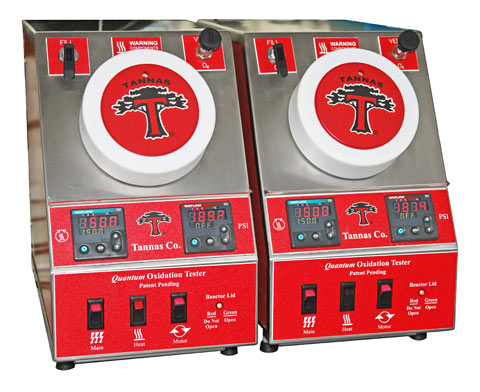
| OELCHECK test instrument: | Reaction vessel with copper spiral and warming bath |
| Sample quantity: | approx. 75 g |
| Unit: | minutes |
| Test result: | oxidation stability of lubricants |
| Analysis for: | oils from turbines, paper machinery or mills, gear oils from wind turbines, hydraulic oils |
| Brief description: | For the test, 50 g of the oil and 5 g distilled water are weighed in a reaction vessel. A polished copper coil is placed into the mixture of oil and water as a catalyst. The reaction vessel is screwed tightly into a pressure-tight stainless steel container. The internal pressure of the pressurised tank can be constantly recorded using a manometer. The apparatus is now filled with pure oxygen up to a pressure level of 620 kPa. The tank with the copper spiral and the oil under oxygenated pressure and exposed to water rotates at 100 rotations per minute at 150 °C. This increase in temperature leads first of all to an increase in internal pressure in the pressure-tight container. The extreme conditions (oxygen, copper, water, temperature) then inevitably lead to oxidation of the oil being tested. The oil reacts with the oxygen, causing the original set oxygen pressure to drop. The ensuing decrease in oxygen demand is recorded as a pressure drop. The actual variable measured is the time span which the internal pressure takes to fall 175 kPa below the maximum. The more time passes until this drop in pressure, the more resistant the oil is to oxidation. |
| Statement: | In large circulation systems, such as turbines, paper machinery or mills, oils must remain in use for several years. However, gear oils in wind turbines and larger hydraulic oil quantities should not be changed well beyond 20,000 operating hours. Accordingly, their oxidation stability plays an important role. The degree of oil oxidation or ageing which has already taken place is usually established by means of FT infrared spectroscopy. However, this does not allow any reliable conclusions to be made regarding the current oxidation stability and the oil's continuing suitability for use. The RPVOT test (RPVOT= Rotating Pressure Vessel Oxidation Stability Test) provides relief. It tests the resistance of fresh oil or oil in use under extremely oxidising conditions. This allows a conclusion about potential oil change intervals to be drawn as quickly as possible. |
| Underlying test standard: | ASTM D2272 |